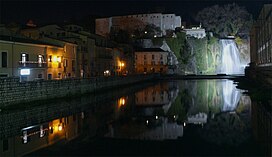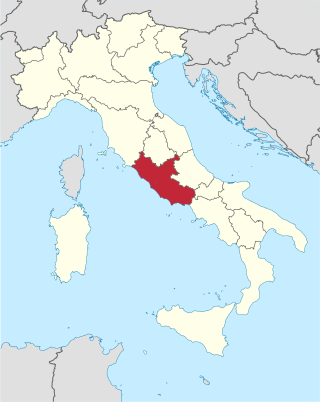
Lazio or Latium is one of the 20 administrative regions of Italy. Situated in the central peninsular section of the country, it has 5,714,882 inhabitants and a GDP of more than €212 billion per year, making it the country's second most populated region and second largest regional economy after Lombardy. The capital of Lazio is Rome, which is also the capital and largest city of Italy, and completely encircles Vatican City.
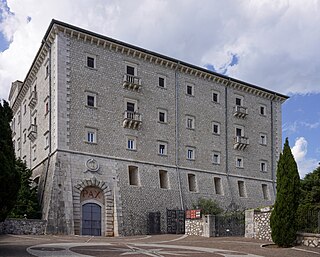
Monte Cassino is a rocky hill about 130 kilometres (80 mi) southeast of Rome, in the Latin Valley, Italy, 2 kilometres west of Cassino and at an elevation of 520 m (1,710 ft). Site of the Roman town of Casinum, it is widely known for its abbey, the first house of the Benedictine Order, having been established by Benedict of Nursia himself around 529. It was for the community of Monte Cassino that the Rule of Saint Benedict was composed.

Sora is a town and comune of Lazio, Italy, in the province of Frosinone. It is built in a plain on the banks of the Liri. This part of the valley is the seat of some important manufacturing, especially of paper mills. The area around Sora is famous for the costumes of its peasants.

Cassino is a comune in the province of Frosinone, Southern Italy, at the southern end of the region of Lazio, the last city of the Latin Valley.
Frosinone is a comune (municipality) in the Italian region of Lazio, administrative seat of the province of Frosinone. It is about 75 kilometres (47 mi) southeast of Rome, close to the Rome-Naples A1 Motorway. The city is the main city of the Valle Latina, an Italian geographical and historical region that extends from south of Rome to Cassino.
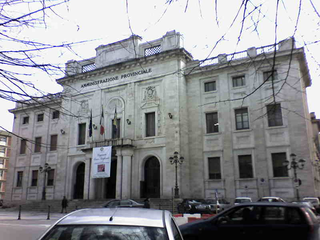
The province of Frosinone is a province in the Lazio region of Italy. Its capital is the city of Frosinone. It has an area of 3,247 square kilometres (1,254 sq mi) and a total population of 493,605 (2016). The province contains 91 comuni, listed in the comuni of the province of Frosinone.

Arpino is a comune (municipality) in the province of Frosinone, in the Latin Valley, region of Lazio in central Italy, about 100 km SE of Rome. Its Roman name was Arpinum. The town produced two consuls of the Roman republic: Gaius Marius and Marcus Tullius Cicero.

Casinum was an ancient town of Italy, of Oscan origin. Varro states that the name in Oscan language meant forum vetus, and also that the town itself was Samnite before the Roman conquest. Casinum was a Samnite city only before the Roman conquest and it is difficult to reconstruct the history in the intermediate period, between Oscans and Samnites, when it had been occupied by the Volsci. It is not known when the city came under Roman supremacy, but it probably received the Roman citizenship in 188 BC. It was the most southeasterly town in Latium adiectum, situated on the Via Latina about 40 miles north-west of Capua. It appears occasionally in the history of the Hannibalic War. Varro possessed a villa near it, in which later on Mark Antony held his orgies.

Latium Adjectum or Adiectum or Latium Novum was a region of Roman Italy between Monte Circeo and the river Garigliano, south of and immediately adjacent to Old Latium and included with it under the Roman Empire.

Arce is a comune (municipality) in the province of Frosinone, in the region of Lazio, Italy. it is an agricultural centre located on a hill overlooking the Via Casilina, in the Latin Valley and in the middle valley of the Liri.

Isola del Liri is an Italian town of Lazio, Italy, in the province of Frosinone. As its name implies, Isola is situated between two arms of the Liri. The many waterfalls of this river and of the Fibreno are used by factories.

The Duchy of Sora was a semi-independent state in Italy, created in 1443 by King Alfonso I of Naples and dissolved in 1796. It occupied the south-eastern part of what is today Lazio, bordering what is now Abruzzo. Its capital was first Sora, and later, under the Boncompagni family, Isola di Sora.
Terra di Lavoro is the name of a historical region of Southern Italy. It corresponds roughly to the modern southern Lazio and northern Campania and upper north west and west border area of Molise regions of Italy.

Roccasecca is a town and comune in the Province of Frosinone, in the Lazio region of central Italy. It is the birthplace of Thomas Aquinas.
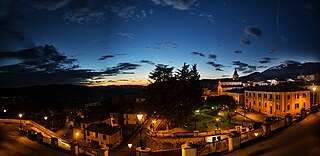
Castelliri is a comune (municipality) of c. 3,500 inhabitants in the province of Frosinone in the Italian region Lazio, located in the valley of the Liri, about 90 kilometres (56 mi) southeast of Rome and about 20 kilometres (12 mi) northeast of Frosinone.

Ciociaria is the name commonly used, in modern times, for some impoverished territories southeast of Rome, without defined geographical limits. Starting from the Fascist period and the creation of the province of Frosinone, the same name was arbitrarily imposed by the local fascist organizations and then misused by the local press, by promotional associations and folkloristic events as a synonym for Frosinone and all the popular traditions of its territory. The local dialect is referred to as campanino in old literature. It is merely a local variants of Central-Italian Latian but is improperly indicated as "ciociaro dialect", although the linguistic and scientific definition is Central-Northern Latian. In more recent times, the term Campagna Romana, or Roman Campagna, a favorite subject of countless painters from all over Europe, has referred to the adjoining region to the north of Ciociaria, but part of the Province of Rome.

The Polo Museale del Lazio is an office of Italy's Ministry of Cultural Heritage. Its seat is in Rome in the Palazzo Venezia.
Isoletta is a village in Italy, in the Valle Latina within the Arce municipality. Isoletta is located in the province of Frosinone, of the southern Lazio region in Italy.

The Valle del Liri is a valley and a geographical region of southern Lazio and part of the larger Latin Valley, located in the province of Frosinone, crossed by the Liri river. The main urban center of the area is Sora.

The Southern Latian dialect is a Southern Italian dialect widespread in the southernmost areas of Lazio, in particular south of the city of Frosinone and starting from the cities of Formia and Gaeta along the coast.
